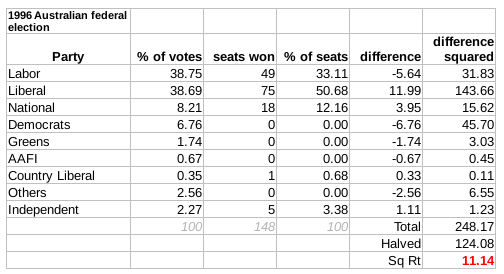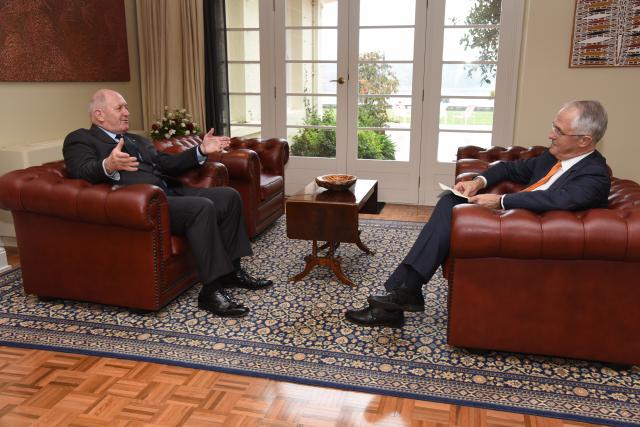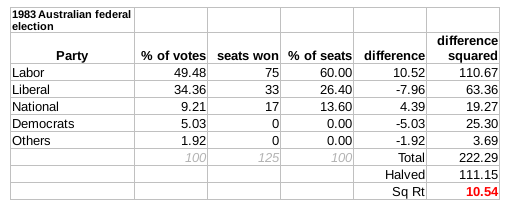|
Ron Boswell
Ronald Leslie Doyle Boswell (born 9 December 1940) is a former Australian politician. He was a Senator for Queensland from 1983 to 2014, representing the National Party. He was the party's Senate leader from 1990 to 2007, a record term. He was also a parliamentary secretary in the Howard government from 1999 to 2003. He was Father of the Senate from 2008 until his retirement in 2014. Early life Boswell was born in Perth on 9 December 1940. In his memoirs he recalled a tumultuous childhood including "two parental separations, frequent changes of school, and an abduction (by his mother, accompanied by her lover) to Melbourne". Boswell spent his early years in Perth, attending five schools in six years. He moved to Brisbane after his father was transferred for work reasons, where he attended St Joseph's College, Gregory Terrace. Boswell left school at the age of 14 and began working as an office boy at an insurance firm. He later worked as an insurance agent and travelling sa ... [...More Info...] [...Related Items...] OR: [Wikipedia] [Google] [Baidu] |
The Honourable
''The Honourable'' (Commonwealth English) or ''The Honorable'' (American English; American and British English spelling differences#-our, -or, see spelling differences) (abbreviation: ''Hon.'', ''Hon'ble'', or variations) is an honorific Style (manner of address), style that is used as a prefix before the names or titles of certain people, usually with official governmental or diplomatic positions. Use by governments International diplomacy In international diplomatic relations, representatives of foreign states are often styled as ''The Honourable''. Deputy chiefs of mission, , consuls-general, consuls and honorary consuls are always given the style. All heads of consular posts, whether they are honorary or career postholders, are accorded the style according to the State Department of the United States. However, the style ''Excellency'' instead of ''The Honourable'' is used for ambassadors and high commissioners only. Africa Democratic Republic of the Congo In the Democrati ... [...More Info...] [...Related Items...] OR: [Wikipedia] [Google] [Baidu] |
Wynnum, Queensland
Wynnum is a coastal suburb in the City of Brisbane, Queensland, Australia. The suburb is a popular destination in Brisbane due to its coastline, jetty and tidal wading pool. In the , Wynnum had a population of 14,036 people. Wynnum and the adjoining suburb Manly were once known as twin towns. Geography Wynnum is on the shores of Moreton Bay in Brisbane, Australia, about by road east of the Brisbane GPO. Toponymy Wynnum likely derives from a Durubalic word meaning pandanus palm (aka 'breadfruit') or mud crab. History Aboriginal history of Quandamooka (Moreton Bay) stretches back over 25,000 years and Aboriginal connection to the Wynnum area (Originally Winnam) has remained strong throughout European colonisation. Thomas Petrie, a visitor in the 1840s, described Wynnum as a large Aboriginal camp (centred on what is now Elanora Park , referred to as Black's Camp as late as the 1980s) for launching expeditions to hunt turtle, dugong and flying fox on the neighbouring ... [...More Info...] [...Related Items...] OR: [Wikipedia] [Google] [Baidu] |
Hawke Government
The Hawke government was the federal executive government of Australia led by Prime Minister Bob Hawke of the Australian Labor Party (ALP) from 1983 to 1991. The government followed the Liberal-National Coalition Fraser government and was succeeded by another Labor administration, the Keating government, led by Paul Keating after an internal party leadership challenge in 1991. Keating was Treasurer through much of Hawke's term as prime minister and the period is sometimes termed the Hawke-Keating government. Background Bob Hawke was president of the Australian Council of Trade Unions (ACTU) from 1969 to 1980. On 14 October 1980, he was preselected as the Australian Labor Party candidate for the Seat of Wills and resigned from the ACTU. Hawke won the seat at the 1980 Election and was appointed as Shadow Minister for Industrial Relations, Employment and Youth Affairs by Opposition Leader Bill Hayden. In 1982, amongst the early 1980s recession, he initiated a leadersh ... [...More Info...] [...Related Items...] OR: [Wikipedia] [Google] [Baidu] |
Confidence And Supply
In parliamentary system, parliamentary democracies based on the Westminster system, confidence and supply is an arrangement under which a minority government (one which does not control a majority in the legislature) receives the support of one or more parties or independent MPs on Motion of no confidence, confidence votes and Government budget, the state budget ("supply"). On issues other than those outlined in the confidence and supply agreement, non-government partners to the agreement are not bound to support the government on any given piece of legislation. A coalition government is a more formal arrangement than a confidence-and-supply agreement, in that members from junior parties (i.e., parties other than the largest) gain positions in the Cabinet (government), cabinet and Minister (government), ministerial roles, and are generally expected to hold the government Whip (politics), whip on passing legislation. Confidence In most parliamentary democracies, members of a p ... [...More Info...] [...Related Items...] OR: [Wikipedia] [Google] [Baidu] |
2007 Australian Federal Election
The 2007 Australian federal election was held in Australia on 24 November 2007. All 150 seats in the Australian House of Representatives, House of Representatives and 40 of the seats in the 76-member Australian Senate, Senate were up for election. The election featured a 39-day campaign, with 13.6 million Australians enrolled to vote. The centre-left Australian Labor Party opposition, led by Kevin Rudd and deputy leader Julia Gillard, defeated the incumbent centre-right Coalition (Australia), Coalition government, led by Liberal Party of Australia, Liberal Party leader and Prime Minister, John Howard, and National Party of Australia, Nationals leader and Deputy Prime Minister, Mark Vaile, by a Landslide victory, landslide. The election marked the end of the 11-year-long Howard-led Liberal–National Coalition government that had been in power since the 1996 Australian federal election, 1996 election. Howard lost his own seat, becoming the first sitting Australian Prime Mini ... [...More Info...] [...Related Items...] OR: [Wikipedia] [Google] [Baidu] |
2001 Australian Federal Election
The 2001 Australian federal election was held in Australia on 10 November 2001. All 150 seats in the House of Representatives and 40 seats in the 76-member Senate were up for election. The incumbent Liberal Party of Australia led by Prime Minister of Australia John Howard and coalition partner the National Party of Australia led by John Anderson defeated the opposition Australian Labor Party led by Kim Beazley. As of 2024, this was the most recent election to feature a rematch of both major party leaders. Future Opposition Leaders Peter Dutton and Sussan Ley entered parliament at this election. Background Throughout much of 2001, the Coalition had been trailing Labor in opinion polls, thanks to dissatisfaction with the government's economic reform programme and high petrol prices. The opposition Australian Labor Party had won a majority of the two-party-preferred vote at the previous election and had won a series of state and territory elections. Labor also recorded positiv ... [...More Info...] [...Related Items...] OR: [Wikipedia] [Google] [Baidu] |
1996 Australian Federal Election
The 1996 Australian federal election was held to determine the members of the 38th Parliament of Australia. It was held on 2 March 1996. All 148 seats of the House of Representatives and 40 seats of the 76-seat Senate were up for election. The Liberal/National Coalition led by Opposition Leader John Howard of the Liberal Party and coalition partner Tim Fischer of the National Party defeated the incumbent Australian Labor Party government led by Prime Minister Paul Keating in a landslide victory. The Coalition won 94 seats in the House of Representatives, the equal-largest number of seats won by a federal government to date (tied with Labor's win in 2025), and only the second time a party had won over 90 seats at a federal election; the first occurred in 1975. The election marked the end of the five-term, 13-year Hawke-Keating Government that began in 1983. Howard was sworn in as the new prime minister of Australia on 11 March 1996, along with the First Howard Ministry. ... [...More Info...] [...Related Items...] OR: [Wikipedia] [Google] [Baidu] |
1990 Australian Federal Election
The 1990 Australian federal election was held in Australia on 24 March 1990. All 148 seats in the Australian House of Representatives, House of Representatives and 40 seats in the 76-member Australian Senate, Senate were up for election. The incumbent Australian Labor Party, led by Bob Hawke, defeated the opposition Liberal Party of Australia, led by Andrew Peacock, with its Coalition (Australia), coalition partner, the National Party of Australia, led by Charles Blunt, despite losing the nationwide popular and two-party-preferred vote. The result saw the re-election of the Hawke government for a fourth successive term, the first time the ALP had won four consecutive terms. __TOC__ Background After John Howard lost the 1987 Australian federal election, 1987 election to Hawke, Andrew Peacock was elected Deputy Leader in a show of party unity. In May 1989, Peacock's supporters 1989 Liberal Party of Australia leadership spill, mounted a successful leadership challenge which retu ... [...More Info...] [...Related Items...] OR: [Wikipedia] [Google] [Baidu] |
1987 Australian Federal Election
The 1987 Australian federal election was held in Australia on 11 July 1987, following the granting of a double dissolution on 5 June by the Governor-General Sir Ninian Stephen. Consequently, all 148 seats in the House of Representatives as well as all 76 seats in the Senate were up for election. The incumbent Australian Labor Party, led by Prime Minister Bob Hawke, defeated the opposition Liberal Party of Australia, led by John Howard and the National Party of Australia led by Ian Sinclair. This was the first, and to date only, time the Labor Party won a third consecutive election. Up until 2025 this was the largest number of seats won at a federal election by the Labor Party. This was the last federal election before Old Parliament House was decommissioned as the seat of parliament after 61 years. In 1988, it was replaced by today's Parliament House, which sits above its predecessor on Capital Hill. Future Opposition Leader John Hewson entered parliament at this election. ... [...More Info...] [...Related Items...] OR: [Wikipedia] [Google] [Baidu] |
1984 Australian Federal Election
The 1984 Australian federal election was held in Australia on 1 December 1984. All 148 seats in the House of Representatives (24 of them newly created) and 46 of 76 seats in the Senate (12 of them newly created) were up for election. The incumbent Labor Party led by Prime Minister Bob Hawke defeated the opposition Liberal–National coalition, led by Andrew Peacock. The election was held in conjunction with two referendum questions, neither of which was carried. Background and issues The election had a long campaign and a high rate of informal voting for the House of Representatives, but decreased rate in the Senate (due to the introduction of the Group voting ticket). Although a House election was not due until 1986, Hawke opted to call an election 18 months early in part to bring the elections for the House and Senate back into line following the double dissolution election of 1983. The legislated increase in the size of the House by 24 seats and the Senate by 12 seats ... [...More Info...] [...Related Items...] OR: [Wikipedia] [Google] [Baidu] |
Double Dissolution
A double dissolution is a procedure permitted under the Australian Constitution to resolve deadlocks in the bicameral Parliament of Australia between the House of Representatives (lower house) and the Senate (upper house). A double dissolution is the only circumstance in which the entire Senate can be dissolved. Similar to the United States Congress, but unlike the British Parliament, Australia's two parliamentary houses generally have almost equal legislative power (the Senate may reject outright but cannot amend appropriation (money) bills, which must originate in the House of Representatives). Governments, which are formed in the House of Representatives, can be frustrated by a Senate determined to reject their legislation. If the conditions (called a trigger) are satisfied, the prime minister can advise the governor-general to dissolve both houses of Parliament and call a full election. If, after the election, the legislation that triggered the double dissolution is sti ... [...More Info...] [...Related Items...] OR: [Wikipedia] [Google] [Baidu] |
1983 Australian Federal Election
The 1983 Australian federal election was held in Australia on 5 March 1983. All 125 seats in the House of Representatives and all 64 seats in the Senate were up for election, following a double dissolution. The incumbent Coalition government which had been in power since 1975, led by Malcolm Fraser (Liberal Party) and Doug Anthony ( National Party), was defeated in a landslide by the opposition Labor Party led by Bob Hawke. This election marked the end of the seven year Liberal–National Coalition Fraser government and the start of the 13 year Hawke-Keating Labor government. The Coalition would spend its longest ever period in opposition and the Labor party would spend its longest ever period of government at a federal level. The Coalition would not return to government until the 1996 election. Hawke became the second Labor leader after World War II to lead the party to victory from opposition, after Gough Whitlam in 1972 and before Kevin Rudd in 2007 and Anthony Albanese i ... [...More Info...] [...Related Items...] OR: [Wikipedia] [Google] [Baidu] |










